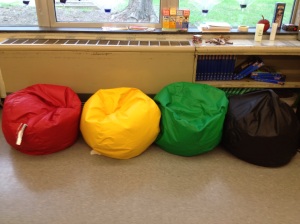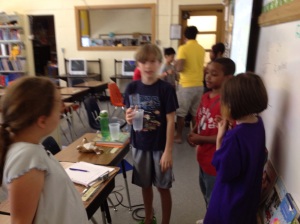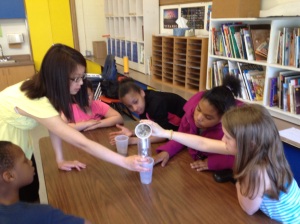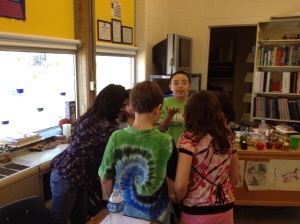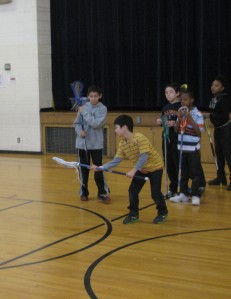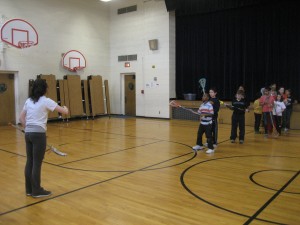Exhaustion is the Key
Today is Thursday and, since we are finally back on something vaguely resembling a regular schedule, it means that we had P.E. this morning. After a few weeks of lacrosse, I decided it was time to bring back some of the basic elements of the President’s Challenge physical fitness program. I wanted to focus particularly on sit-ups (or curl-ups), push-ups, and endurance running, since those are all activities that each of my students can do fairly easily and can do inside the gym.
So I led my class down to the gym, had them do some warm-ups for a few minutes, and then split them into partners. They had three minutes to do as many sit-ups as they could (one student did sit-ups while the other counted and encouraged them). Then they switched places and did it again. I had the class line up, report how many they did, then spread out with their partners again to do as many push-ups as possible in three minutes and then, just like before, they switched places. They lined up, reported their numbers, and then they all gathered in a far corner of the gym and were told to run laps around the gym for five minutes and see how many laps they could do. After reporting their numbers for a third time, I had the class sit in a circle in the gym and take turns sharing one positive thing about someone in the class. This last is something I’ve done from time to time and would like to do more often, as I think it is helpful for the class to remember to keep things positive, especially with one another!
After our P.E. time, we went to the Book Exchange and then did silent reading in the classroom. The class was quite subdued throughout the morning and even during the afternoon. Nearly everyone was working on what they were supposed to be doing, they kept focused, and they met all of our classroom expectations during the morning and the afternoon. At the end of the day, I had a thought:
Maybe having them do a bunch of sit-ups, push-ups, and running around first thing each morning is the key to decrease discipline problems! Maybe the students will just be so exhausted after their workout that they won’t have the energy to disrupt class!
Probably not. And I actually doubt that there was any correlation between the two. In fact, I really think that today was just one of those days in which the class had it all together, collectively and independently. But it is tempting to test my theory…
Real-Life Applications of Fourth Grade Math
Over Spring Break, I had an opportunity to chat with a friend of mine about what is taught in fourth grade, particularly in math. He is in a railroad engineering program, and has to use fairly advanced math on a regular basis for his work.
But then he pointed out that he only uses advanced math for his rather technical work. When it comes to day-to-day activities, the type of math he uses, if he uses math at all, is essentially what I teach my students: addition, subtraction, basic multiplication, division, fractions, and simple probability.
So, of course, I decided to use this as the springboard for math instruction today. Because, you know, having an engineer admit that the math he learned in fourth grade is what he uses most often is much more impressive to my students than to hear it from their teacher.
I have two math groups in my class. I told the first group about this, and then transitioned into a story about my wife and I eating some red velvet cake over the weekend. I explained that I made a cake, cut it into twelve pieces, and then had to leave for a few hours. While I was gone, my wife at a fourth of the cake. When I got home, I ate a third of what was remaining. I asked them to figure out how many pieces of cake we each ate.
With the other group, I talked about planning a trip to Kansas City, Missouri, to visit my oldest brother and his family at some point. I explained that it will take about six hours to drive there, and we need to figure out how much gas we will need to get there. I told them that we know the trip to Washington, Illinois, where my parents live, takes about an hour and a half by car. So I asked them to figure out how many times longer the dive to Kansas City would be. Then I said that we use about three gallons of gas to get to Washington, so I need to figure out how much gas it would take to get Kansas City. I wrapped up with pointing out that gas currently costs $3.96 per gallon, but we should just round up the number to figure out about how much gas we’ll need for the round trip.
After each group figured out the answers to these problems, I reinforced the point that this is the kind of math adults use every day; the same kind of math that they are learning right now in class. Of course, that doesn’t mean advanced math doesn’t have its uses. People definitely do use calculus for some types of work. But when it comes to daily activities, most of us aren’t going to break out the quadratic equation when figuring out how much gas will cost for a trip.
That didn’t stop me from quickly throwing the equation up on the board, just to show them what it is. After all, my high school calculus teacher, Mr. Charles “Chuck” Brunner, spent an awful lot of time helping me and my friends learn it. And now, ten years later, I still remember it: x equals opposite of b plus or minus the square root of b squared minus 4ac all over 2a.
Inquiry-Based Learning
One of my preferred methods of teaching is inquiry-based learning. There are many aspects to this, but the one that I like to focus on with my students is simply the process of asking questions and then finding answers.
I have been tying this into our science work during the past few weeks, and plan on continuing to do so for the rest of the year. As you may know, I had recently placed an order that resulted in four large boxes ending up in my classroom.
Today was our first day back after Spring Break, and I was very pleased that the students were immediately captivated by the four boxes stacked up on our reading table. I made sure they knew that no one was allowed to touch the boxes, but they were allowed to look. On the board, where I write a message to get them started each day, was the assignment to take out a piece of paper and write about what they thought was in the box and why they thought that.
After getting through the first part of the morning, I donned my lab coat and asked the students to share their predictions. Many of them immediately knew what was coming next: observations, more observations, and then an explanation. I didn’t ask the students to share their predictions with the class. What I did do is allow them to make further observations of the boxes by watching what I could do with them. I lifted them, demonstrated how tall they were in comparison to me, and shook them around a bit. The students then amended their predictions. Then I looked inside the boxes and told them that the boxes contained items that were red, yellow, green, and black.
After predicting and observing, I introduced two new elements of the inquiry method. The first is consensus. I had the students go around and find others who agreed with their predictions and observations. I pointed out that scientists often share their findings and methods so that others can try to replicate them and see if they come up with the same results. If everyone agrees, it is quite likely (although not guaranteed) to be a strong theory. After the students reached a consensus (of the 22 who were present in the morning, 21 of them agreed the boxes contained the same thing), I revealed the last element of the inquiry method: results. I wanted the students to know what was in the boxes and then be able to share the results with others (in this case, their class members). And so I stood up on a chair, flipped the boxes over, and dumped out their contents:
Our new beanbag chairs will, of course, be used on a regular basis as we move into a new approach to literacy instruction in our classroom. But more on that, later.
Something’s Coming…
I hope you have all been enjoying the week thus far! My Spring Break so far has entailed the following:
Monday: Went to the classroom and did some housekeeping in the morning.
Tuesday: Served as an Election Judge for Champaign County’s primary elections in the Cunningham 7 and 8 precincts in Urbana.
Wednesday: Decided to have one day during which I would do absolutely nothing productive; I finished a book, watched several episodes of The X-Files, and took a two-hour nap.
Thursday: Helped me wife with an emergency at her office. Oh, and I finally got a delivery that I’ve been waiting for for several weeks:
Something’s coming to my classroom! I hope my students enjoy the surprise!
I’ll be working on third quarter report cards during most of tomorrow. Happy day!
Penny Basketball
As has been mentioned several times now, this week has been a week of special guests and visitors for our classroom. One of the special guests we’ve had is a fellow participant in the Literacy Across Content Areas inquiry group who works at the University of Illinois as one of the Teacher Collaborators. (He is, incidentally, different from the other Teacher Collaborator who was with our class on Monday morning to check out what they were doing on Storybird.) He has worked with my students each day this week to introduce them to a game he created called Penny Basketball.
Penny Basketball is an easy game that allows students to explore fractions, ratios, and percents while interpreting data in a fun and engaging manner. We started on Monday with the introduction of the basic concepts behind the game and taught the students how to shoot free throws. We spent two days discussing how to determine who the best penny basketball free throw shooter in the class is by recording successful shots and comparing them to the number of shots taken. Students were randomly assigned a number of attempts they could take: 6, 8, 10, or 12. Then the students compared the fractions within groups and then across the class. After trying to compare fractions, we showed them how to convert fractions into percents and compared them again.
Yesterday was the introduction of the full game of Penny Basketball and we asked the students to consider the question of who is the best penny basketball player in the class. We then had the class play the full game for several rounds today and record data.
It has been a lot of fun watching the students learn how to manipulate numbers, record data, and realise that there are multiple ways to interpret the same information. We are going to spend one more day on Penny Basketball tomorrow. I am going to set a new challenge for the class: instead of trying to determine who is the best, I want them to figure out how to arrange the game so that everyone does really well. In other words, instead of competing against each other, I want them to learn how to work with each other.
UMS Concert at Wiley
Today was one of many wonderfully exciting days for my classroom. We, along with our entire building, were fortunate enough to have a special visit from the music department of Urbana Middle School (UMS being, of course, the school that all of our students will feed into after completing fifth grade).
This visit was manifest as a special 30-minute concert. It started with the String Ensemble performing a couple of selections after introducing the instruments (violin, viola, cello, and string bass). Then the 8t grade chorus sang two pieces, the second one including a number of solos. I was saddened to see that there were only two boys in the 8th grade chorus, but I am assuming that the boys are only able to do so many things, and being in the chorus is probably not high on the list. (To be perfectly honest, though, I wasn’t in the chorus when I was in middle school. I joined my sophomore year of high school.) The assembly ended with a performance by the concert band. The director introduced the typical introductory instruments: flute, clarinet, trumpet, and trombone, but she pointed out that they also had percussion, French horns, oboes, baritones, and a tuba.
After the concert, I led a brief discussion in our classroom about being in band and chorus. I encouraged everyone in my class to join the beginning band in 5th grade. I then suggested to the students that I could play instrumental music on my computer while they do silent literacy work (reading and/or writing). I received an enthusiastic reply, and so we tried it out today. They seemed to quite enjoy reading and writing while listening to a wide variety of instrumental music, including classical, soundtracks, and modern selections. We will do this again tomorrow and see how they do after the initial novelty has worn off!
Student Observations – Day One
I wrote yesterday about how my students have begun a science experiment to see what would happen if they put a cup of coloured water in a sealed bag and then hung it in the window. They had to make predictions about what they thought would happen and justify the prediction with an explanation. (This is all part of my “what and how” policy, also known as the “Don’t tell me; show me!” policy.)
I told the class that they would record their observations on Wednesday, after the apparatuses had been in place for a couple of days.
Of course, this didn’t stop anyone from making a bee-line to the windows when the arrived this morning to see if anything had happened yet! This filled me with a great sense of joy and excitement because my somewhere-close-to-10-years-old students were excited about looking at water in a bag. Coloured water, mind you, but I don’t think anyone of them really cared about that part of it. They wanted to see whether or not their predictions were coming true.
Some of the bags had what appeared to be fine droplets of water on the sides. Others had tiny pools of water in the bottom corners. Some had large droplets on the sides but not much else. A few had bubbles in the water still in the cups. One student’s apparatus had to be reassembled because it fell off the window. I also had to help four students through the prediction and assembly process. Three were absent yesterday, while the fourth was a new student in our class. (I think it is an indicator of how excited the students were about the projects that cups of water inside resealable bags were more exciting than the prospects of meeting a new student.)
We are going to record formal observations tomorrow, and then again Friday. I am hoping that nothing dramatic will happen over the next couple of days, so then the bags can stay in place throughout Spring Break and, hopefully, there will be a noticeable difference!
Classroom Experiments
For a variety of reasons, the science work we have done in my classroom this year has not involved any direct experimentation. We have studied topics, discussed different issues, read books related to science concepts, and watched movies, but we haven’t done any experiments.
Part of this is related to the fact that our science curriculum doesn’t particularly lend itself to experimentation. The concepts we are to cover include research and inquiry, life sciences, earth sciences, and physical sciences. The life sciences are most about habitats and food chains. Earth sciences cover weather and erosion, and physical sciences cover electricity and magnetism.
We started working on weather and the water cycle a few weeks ago. With this being the last week before Spring Break, I wanted to do a lot of fun, interactive lessons. (I do a lot of fun, interactive lessons anyway, but I particularly wanted to focus on them this week.) I remembered a science experiment I did in my class when I was in grade school (not in fourth or fifth grade, though), and I realised it would be great for this week.
Among other things, it is finally warm outside and the sun is shining more often than not. So the experiment is this: a half-full clear cup of coloured water is put in the bottom of a gallon-sized resealable bag, the bag is closed, and the apparatus is taped to a window. The students then do three things: first, they predict what will happen to the water; second, they will observe the bags for a week; third, they will explain what happened.
To explain this process, I told the students that they will be completing a P-O-E chart:
Predict: What will happen?
Observe: What is happening?
Explain: What happened?
I learned about this approach to scientific inquiry while studying for a semester in Australia, and realised it is a very student-friendly approach to the scientific method.
The students predictions have been varied. Some say that nothing will happen to the water. Some say that the water will get heated by the sun and evaporate. Some predicted that the water will go through the stages of the water cycle by evaporating, condensing, and precipitating.
I am looking forward seeing how this experiment works. Due to the location of our room, we are in shadow during large portions of the day, but I think the process will still work as expected. (I am not going to say what I expect to happen, though, since many of my students do read this blog!) If it doesn’t work out, we will have to come up with an explanation for what happens!
ISAT – Day Four
After four days, eight tests, and roughly nine hours, we are officially done with ISAT testing! Deciding to make this week my personal March Madness has turned out to be a fairly accurate description!
The students had a hard time keeping focused to the very end, but they made it! The final tests today were the two science sessions. I think that the one thing that helped them stay on task all the way to the end was the fact that the tests were on concepts they hadn’t seen throughout the week!
As I walked around the room monitoring students, I realised something really awesome about the ISAT tests: they provide a perfect environment for watching students think.
Now, don’t get me wrong. I get to see students think every day. But on regular days, the thinking is done in the midst of noise, semi-chaos, and multiple activities. During ISATs, the students are spaced throughout the room, working independently, and silent. So when I see their thinking, I see it without the background noise. If I could have taken pictures or videos of their faces as they thought through the problems, I would have. It was, quite simply, splendid to observe.
Alas, testing is done. We will be celebrating tomorrow and preparing for the coming week, which is the last week before Spring Break. I am so proud of my fourth graders for their hard work this week!
ISAT – Day Three
ISBE March Madness 2012 is now done for students in grades three and five. Fourth grade, on the other hand, has one more day of testing to go.
We finished the reading and mathematics tests today, which was a great relief to many in the class. As with the previous days, everyone seemed very confident with how the tests went. I realised yesterday after school that I had not given any kind of direct instruction on how to do an extended-response question for math for the ISAT. (Extended-response itself has been covered repeatedly.) I rectified this the best I could this morning by doing a quick review of the T-chart method.
The T-chart is pretty simple: the students show their work on the left side of the vertical bar and then explain why they did each step on the right. The hardest part for many students when doing an extended response is being able to explain their reasoning.
I don’t have the privilege of seeing the students responses on the tests, other than the snippets I catch as I walk around making sure that everyone is working and recording their responses in the right spaces. However, it seemed like most everyone was indeed making an effort to answer the extended response questions completely.
Other than testing, we took time this morning to discuss the proposed college research project. I told the class that I was going to have them do a compare/contrast research project between a colonial college/university and a modern one. I also explained the restriction that they could not use the University of Illinois or Parkland College. Finally, I told them that I’d like them to think about the questions they’d like to answer. To prime the thoughts, I gave them the name of an actual colonial college, the College of William and Mary. I then recorded their questions as they asked them. Here is what they came up with:
(Click the image to see the full-size, high-resolution image.)
I continue to be impressed by the higher-order thinking my students continue to exhibit through their questions. They also definitely ask questions that I would never think of asking, although I did redirect them with more specific language. (For example, one student asked what kind of libraries, stores, and restaurants are available, and I rewrote it to ask about amenities. What can I say? I can’t resist sharing new words with my students!)
Oh, and I also gave my students a challenge that I can’t write lest I give away the answer. It is about the three words in English that all sound the same: to, too, and two. You can speak the sentence that says there are three ways to spell the word that sounds like that, but how do you write it? I know, my explanation is awful. If you are a parent with a child in my class, just ask them what the challenge is and see if they remember.
One more day of testing to go!
ISAT – Day Two
We are now halfway through the ISAT exams for this week! The students did a great job during the testing again, and seemed very confident about their results.
Except for the short-response question during the mathematics session about range–we haven’t covered mean, median, mode, and range yet, so several of the students weren’t sure what it meant. While I do not, at present, have the capability to travel back in time to address this issue, I will be giving a considerable amount of thought over the next few months to figure out how to better prepare my class for ISATs next year.
Before we started testing in the morning, I was talking to the class briefly about the Boston College hoodie I was wearing today. I admitted that I have never been to Boston, but I had a sister go to school there and a friend who is working at MIT now. I also explained that most of my hoodies were gifts given to me by friends who attended colleges and universities all around the United States.
Suddenly, one student raised his hand and asked a question that made my heart thrill: “Mr. Valencic, can we do a research project on different colleges and universities next week?! And can we go around and share what our favourite schools are?!”
There was a spontaneous cheer of approval from his classmates. There was, of course, no way that I would tell my students no to such a question! I am going to come up with guidelines for the the research and find ways to tie it into some of the other topics we are studying. I know of one restriction I am going to make right now: no student can research the University of Illinois or Parkland College. After all, I want them to learn new things. The more I think about it, the more I think I may have them focus on some of the older schools in the nation. That will tie in quite well with our early American history unit. Definitely something to think about while the students are testing tomorrow and Thursday!
ISAT – Day One
March Madness has officially begun.
Not the NCAA March Madness, but the ISBE March Madness.
Also known as ISAT week.
Our schedule for this week looks something like this:
8:15 am School starts
9:00 am Specials (Fine Arts/Library)
9:30 am Prepare for morning testing
10:15 am Morning Testing (Reading)
11:45 am Lunch
12:30 pm Class Meeting/Read Aloud
1:00 pm Prepare for afternoon testing
1:20 pm Afternoon Testing (Mathematics)
2:30 pm Afternoon Recess
3:00 pm School ends
This schedule will go on with little interruption for the next two days. Thursday’s schedule is slightly different, because fourth grade is the only class taking the science tests.
When I first examined the testing schedule, I found myself wondering what I was going to do during the short breaks between testing. I quickly found out today that those breaks don’t really exist, so there isn’t that much down time that needs to be “filled.” Even the time in the morning before Specials quickly passes with students just getting settled, getting prepared, and doing some quick reviewing with the class.
Because I decided to think of ISAT testing week as March Madness, I decided to do something totally different this week, as far as my clothing goes. Instead of wearing my usual dress shirt, tie, and slacks combination, I am wearing jeans, sneakers, and college hoodies. I have more than enough, anyway, and I’ve wanted to find a way of integrating them into the classroom. The students were quick to adapt to this sudden change of attire, which was good. The day, too, was good. The students seemed confident and excited. One of my favourite comments at the end of the day came from a boy who frequently struggles academically. He came up to me when he was done and said, “Oh man, Mr. Valencic, I did great! I burned that test!”
He was so excited and so happy to tell me how well he felt he had done. I hope that everyone felt that way!
The End
I believe I have mentioned this from time to time, but I can’t find any of the posts in which I did so, and I just don’t feel like looking through all of them right now. The “this” of which I speak is that I have worn a different tie to work each day since October 31.
There wasn’t a particular reason for this, other than boredom and curiosity. I had never counted how many ties I owned, although I knew I had at least 48 and probably less than 100. I mentioned this to my class, and asked them to make predictions as to how long I could go before repeating a tie. The predictions ranged from a few days to a few months to 364 days. My own prediction was that I could make it all the way to Spring Break.
I was able to wear all of my Christmas ties in the weeks before the winter break, and I tried to rotate in novelty ties in an even spacing. Some of my students claimed that I wore one tie a second time a few weeks ago, but I am pretty certain they were merely confusing it with another that, to be fair, does look an awful lot like it.
Finally, I was down to the last few ties. I was hoping I could make it all the way to the end of this week, but it didn’t look like I’d make it. Then I remembered: I owned one more tie, but it isn’t really a tie. It is a clip-on. I wore it yesterday, marking day 122 since October. Of course, that includes weekends, holidays, and professional development days (like conferences), and school assemblies. I didn’t wear ties on those days (except for Sundays, but I wasn’t going to include wearing ties to church in the experiment.
So, by my count, I own (and wore) a total of 64 60 ties (I thought there were more, but I counted again), not including my two bow ties and my bolo. I think I need more ties.
Lacrosse
Several weeks ago, I received an email from my principal regarding an email she had received from two of the members of the Illinois Women’s Lacrosse Club. The email was offering to come in during a P.E. time and share the sport with them. Even though the sport is separated by gender, they assured me they had activities for boys and girls.
I was quite pleased to see this email, for a number of reasons:
- I love having outside experts come in and share with the class what they do to provide a “real world’ perspective and
- I don’t know how to teach P.E. (I took a grand total of one class on the subject, and that was back in 2001 or maybe 2002. I honestly have no real training on the matter, so I am kind of winging it…)
So, with those two points in mind, I emailed the lacrosse girls and said, yes, please come to my class and teach them about this sport! We arranged a schedule, but there was a miscommunication, so it got bumped a week later. That happened to be last Thursday, which was when I was at the INTC Conference, so I missed the first day of lacrosse.
Fortunately, they were able to come again today, which had my class totally stoked! Everyone was participating and having a great time learning about lacrosse. (I’d love to introduce my class to rugby, but I think that sport may be just a tad bit too rough for fourth graders…) I was also able to snap some photos of the students practicing drills with the lacrosse women:
Here are some of the students practicing catching the lacrosse balls.
The students did a relay where one of the lacrosse players would toss the ball and the students took turns trying to catch it. The goal was 5 catches. I think this group got ten or so.
Here’s the other group doing the relay; they had twenty catches!
Another action shot of the relays. The students all had a great time!
We have ISAT testing next week, which will get in the way of having P.E., but the lacrosse girls are going to try to come back the following week for one more day of lacrosse. They’ve also invited the entire class to come to their first matches of the Spring season on Saturday, March 31, at the fields on First and Peabody in Champaign. The games start at 9:30 am.

